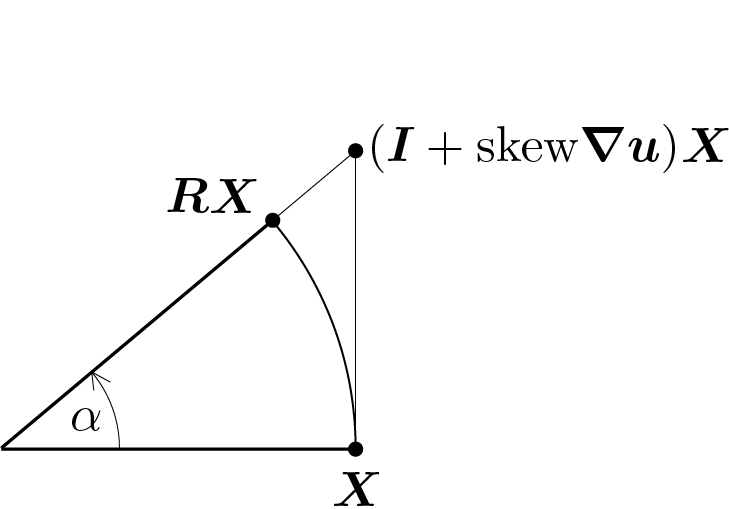Section 1.9 the infinitesimal strain tensor
It often happens in applications that the norm of the displacement gradient is small. In these cases the contribution \(\transp{\tens{\nabla u}} \, \tens{\nabla u} \) appearing in the expressions of the tensor \(\tens{E}\) and tensor \(\tens{C}\) becomes negligible. Therefore the Green-Lagrange strain tensor will be coincident with the infinitesimal strain tensor \(\tens{\varepsilon}\text{,}\) i.e.
while Cauchy tensor can be written as
Subsection 1.9.1 infinitesimal motions
Let us start by recalling the explicit expression of the components of the displacement \(\vec{u}\)
and of its gradient \(\tens{\nabla u}\)
The following decomposition of \(\tens{\nabla u}\)
true for all tensor, allows to insert in a more general framework the tensor of the infinitesimal strain previously introduced and the role played by \(\tens{\nabla u}\) in the description of the infinitesimal motions. By infinitesimal motions we will therefore mean the motions characterized by the condition \(\|\tens{\nabla u}\| \rightarrow 0\text{.}\)
- The symmetric part, \(\text{sym}\tens{\nabla u}\text{,}\) whose matrix expression is\begin{equation} \mat{\varepsilon} = \text{sym}\mat{\nabla u}= \left[\begin{array}{ccc} \regulardiff{u_1}{X_1} \amp \frac{1}{2}\left(\regulardiff{u_1}{X_2}+\regulardiff{u_2}{X_1}\right) \amp \frac{1}{2}\left(\regulardiff{u_1}{X_3}+\regulardiff{u_3}{X_1}\right)\\ \frac{1}{2}\left(\regulardiff{u_2}{X_1}+\regulardiff{u_1}{X_2}\right) \amp \regulardiff{u_2}{X_2} \amp \frac{1}{2}\left(\regulardiff{u_2}{X_3}+\regulardiff{u_3}{X_2}\right)\\ \frac{1}{2}\left(\regulardiff{u_3}{X_1}+\regulardiff{u_1}{X_3}\right) \amp \frac{1}{2}\left(\regulardiff{u_3}{X_2}+\regulardiff{u_2}{X_3}\right) \amp \regulardiff{u_3}{X_3} \end{array}\right]\,,\label{mat_symDu_eq}\tag{1.9.4} \end{equation}gives the infinitesimal strain tensor \(\tens{\varepsilon}\) whose components are denoted as follows\begin{equation} \mat{\varepsilon} = \left[\begin{array}{ccc} \varepsilon_{11} \amp \varepsilon_{12} \amp \varepsilon_{13}\\ \varepsilon_{21} \amp \varepsilon_{22} \amp \varepsilon_{23}\\ \varepsilon_{31} \amp \varepsilon_{32} \amp \varepsilon_{33} \end{array}\right]\,.\tag{1.9.5} \end{equation}
- The skew part, \(\text{skew}\tens{\nabla u}\text{,}\) whose matrix expression is\begin{equation} \text{skew}\mat{\nabla u}= \left[\begin{array}{ccc} 0 \amp \frac{1}{2}\left(\regulardiff{u_1}{X_2}-\regulardiff{u_2}{X_1}\right) \amp \frac{1}{2}\left(\regulardiff{u_1}{X_3}-\regulardiff{u_3}{X_1}\right)\\ \frac{1}{2}\left(\regulardiff{u_2}{X_1}-\regulardiff{u_1}{X_2}\right) \amp 0 \amp \frac{1}{2}\left(\regulardiff{u_2}{X_3}-\regulardiff{u_3}{X_2}\right)\\ \frac{1}{2}\left(\regulardiff{u_3}{X_1}-\regulardiff{u_1}{X_3}\right) \amp \frac{1}{2}\left(\regulardiff{u_3}{X_2}-\regulardiff{u_2}{X_3}\right) \amp 0 \end{array}\right]\,,\tag{1.9.6} \end{equation}represents the infinitesimal rotation tensor.
- For a generic infinitesimal motion we have\begin{equation} \text{sym}\tens{\nabla u} \neq \tens{0}\,,\quad \text{skew}\tens{\nabla u} \neq \tens{0}.\tag{1.9.7} \end{equation}
- For a rigid infinitesimal motion we have\begin{equation} \text{sym}\tens{\nabla u} = \tens{0}\,,\quad \text{skew}\tens{\nabla u} \neq \tens{0}.\tag{1.9.8} \end{equation}
Insight 1.9.1. meaning of the components of the infinitesimal strain tensor.
In order to identify the meaning of the components of the tensor \(\tens{\varepsilon} \) it is better to start with the expression of tensor \(\tens{C}\) with respect to the gradient of the displacement, that is
from which, making the calculations, for example with the following MATLAB® instructions
syms u1_X1 u1_X2 u1_X3 u2_X1 u2_X2 u2_X3 u3_X1 u3_X2 u3_X3 Du = [u1_X1 u1_X2 u1_X3;u2_X1 u2_X2 u2_X3; u3_X1 u3_X2 u3_X3] C = diag([1 1 1]) + Du + transpose(Du) + transpose(Du)*Du C(1,1) C(1,2)
the expressions of a component on the main diagonal and one outside can be obtained, i.e.
For the diagonal component, using the (1.8.4) result obtained for the \(\tens{C}\) diagonal component, it is possible to write
From which
A similar result is valid for the other components of \(\tens{\varepsilon}\) belonging to the main diagonal.
For the off-diagonal component, by using (1.8.6), it can be obtained
and then
Insight 1.9.3. infinitesimal rotations.
To explain the denomination "infinitesimal rotation" that has been given to the skew part of the gradient of the displacement, it is convenient to discuss a transformation characterized only by a simple rotation. To this end, consider a rotation around the \(\vec{e}_3\) axis. The significant part of the transformation can be directly discussed in the plan as follows
The displacement field is
With this information it is possible to calculate the deformation gradient which, in the specific case, is composed only of the rotation
where, as already discussed before,
Moreover
and then
Result that highlights the decomposition of the gradient of the displacement with
decomposition that, for now, is generic because no reference to infinitesimal displacements has been introduced.
To assume infinitesimal displacements implies also very small values for the angle \(\alpha\text{,}\)\(\alpha \ll 1\text{,}\) i.e. \(\cos{\alpha}\approx 1\) and \(\sin{\alpha} \approx \alpha\text{.}\) From which
Therefore in the case of infinitesimal displacements expression (1.9.11) can be rewritten as follows

Above in the figure the obtained result is emphasized showing the difference between the vector obtained by applying \(\tens{R}\)
and the vector obtained applying the approximation of \(\tens{R}\) given by \((\tens{I} + \text{skew}\tens{\nabla u})\)
Insight 1.9.5.
Given a skew tensor \(\tens{W}\) characterized by the following matrix form
it easy to verify that to apply \(\tens{W}\) to a vector \(\vec{v}\)
is equivalent to calculate the following vector or cross product
where the components of \(\vec{\omega}\) are related to the components of \(\tens{W}\) as follows
On the contrary, knowing \(\vec{\omega}\text{,}\) \(\tens{W}\) can be evaluated as follows
Eventually the following relationship can be stated
where \(\omega\) is the axial vector associated to the skew tensor \(\tens{W}\text{.}\) The adjective axial is used for the vector \(\omega\) because it represents the rotation axis of the infinitesimal rotation.
